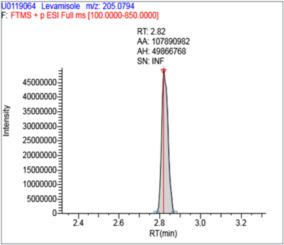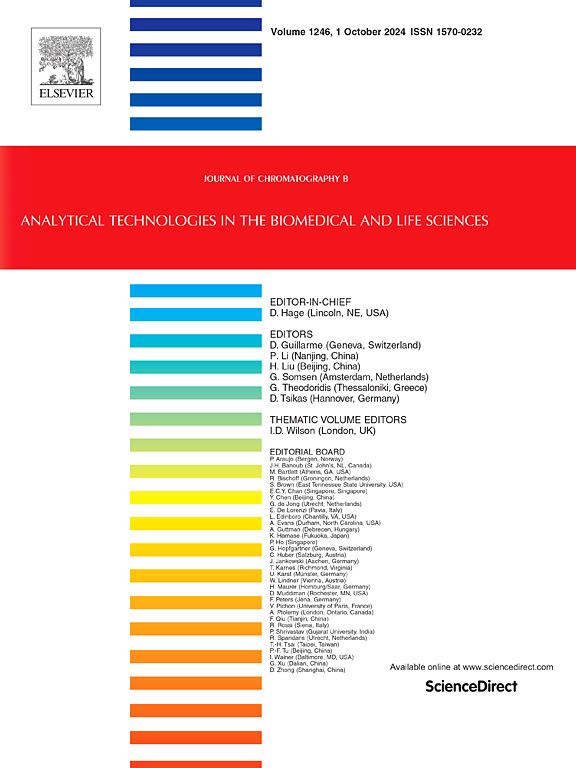Development and validation of general urine screening method for performance enhancing drugs in racehorses utilizing liquid chromatography-high resolution mass spectrometry (LC-HRMS)
IF 2.8
3区 医学
Q2 BIOCHEMICAL RESEARCH METHODS
引用次数: 0
Abstract
The complexity of the drug market and the constant updating of drugs have been challenging issues for drug regulatory authorities. In this manuscript, a high-throughput automated assay based on Liquid Chromatography High Resolution Mass Spectrometry (LC-HRMS) suitable for use as an initial testing procedure covering multiple classes of compounds prohibited in horse racing is described. The assay requires a 250-μL urine aliquot, which is subjected to enzymatic hydrolysis followed by Biotage Isolute supported liquid extraction plates using Biotage Extrahera system, evaporation, and reconstitution in a 96-well collection plate. LC–HRMS analyses were carried out on a Thermo Fisher Q-Exactive Mass spectrometer (equipped with HESI source interface) coupled with Vanquish UHPLC system linked to ACE Excel column. Drug targets were identified by retention time and accurate mass, with a mass tolerance window of +/− 5 ppm. The screening method was validated for over 250 drug targets and/or their metabolites in a 7-min run. Validation data including sensitivity, specificity, extraction recovery and precision are presented. As the method employs full-scan mass spectrometry, an unlimited number of drug targets can theoretically be incorporated.

利用液相色谱-高分辨质谱(LC-HRMS)建立和验证赛马尿液中兴奋剂的通用筛选方法。
药品市场的复杂性和药品的不断更新对药品监管部门来说是一个具有挑战性的问题。在这篇手稿中,描述了一种基于液相色谱-高分辨率质谱(LC-HRMS)的高通量自动化分析方法,适合用作涵盖赛马中禁止的多种化合物的初始测试程序。该检测需要250 μ l的尿液,经酶解,然后使用Biotage Extrahera系统进行Biotage Isolute支撑的液体提取板,蒸发,在96孔收集板中重组。LC-HRMS分析采用Thermo Fisher Q-Exactive质谱仪(配备HESI源接口)与Vanquish UHPLC系统连接至ACE Excel柱。通过保留时间和精确质量来确定药物靶标,质量耐受窗口为+/- 5 ppm。该筛选方法在7分钟内对250多种药物靶点和/或其代谢物进行了验证。验证数据包括灵敏度、特异度、提取回收率和精密度。由于该方法采用全扫描质谱法,理论上可以纳入无限数量的药物靶标。
本文章由计算机程序翻译,如有差异,请以英文原文为准。
求助全文
约1分钟内获得全文
求助全文
来源期刊

Journal of Chromatography B
医学-分析化学
CiteScore
5.60
自引率
3.30%
发文量
306
审稿时长
44 days
期刊介绍:
The Journal of Chromatography B publishes papers on developments in separation science relevant to biology and biomedical research including both fundamental advances and applications. Analytical techniques which may be considered include the various facets of chromatography, electrophoresis and related methods, affinity and immunoaffinity-based methodologies, hyphenated and other multi-dimensional techniques, and microanalytical approaches. The journal also considers articles reporting developments in sample preparation, detection techniques including mass spectrometry, and data handling and analysis.
Developments related to preparative separations for the isolation and purification of components of biological systems may be published, including chromatographic and electrophoretic methods, affinity separations, field flow fractionation and other preparative approaches.
Applications to the analysis of biological systems and samples will be considered when the analytical science contains a significant element of novelty, e.g. a new approach to the separation of a compound, novel combination of analytical techniques, or significantly improved analytical performance.
 求助内容:
求助内容: 应助结果提醒方式:
应助结果提醒方式:


